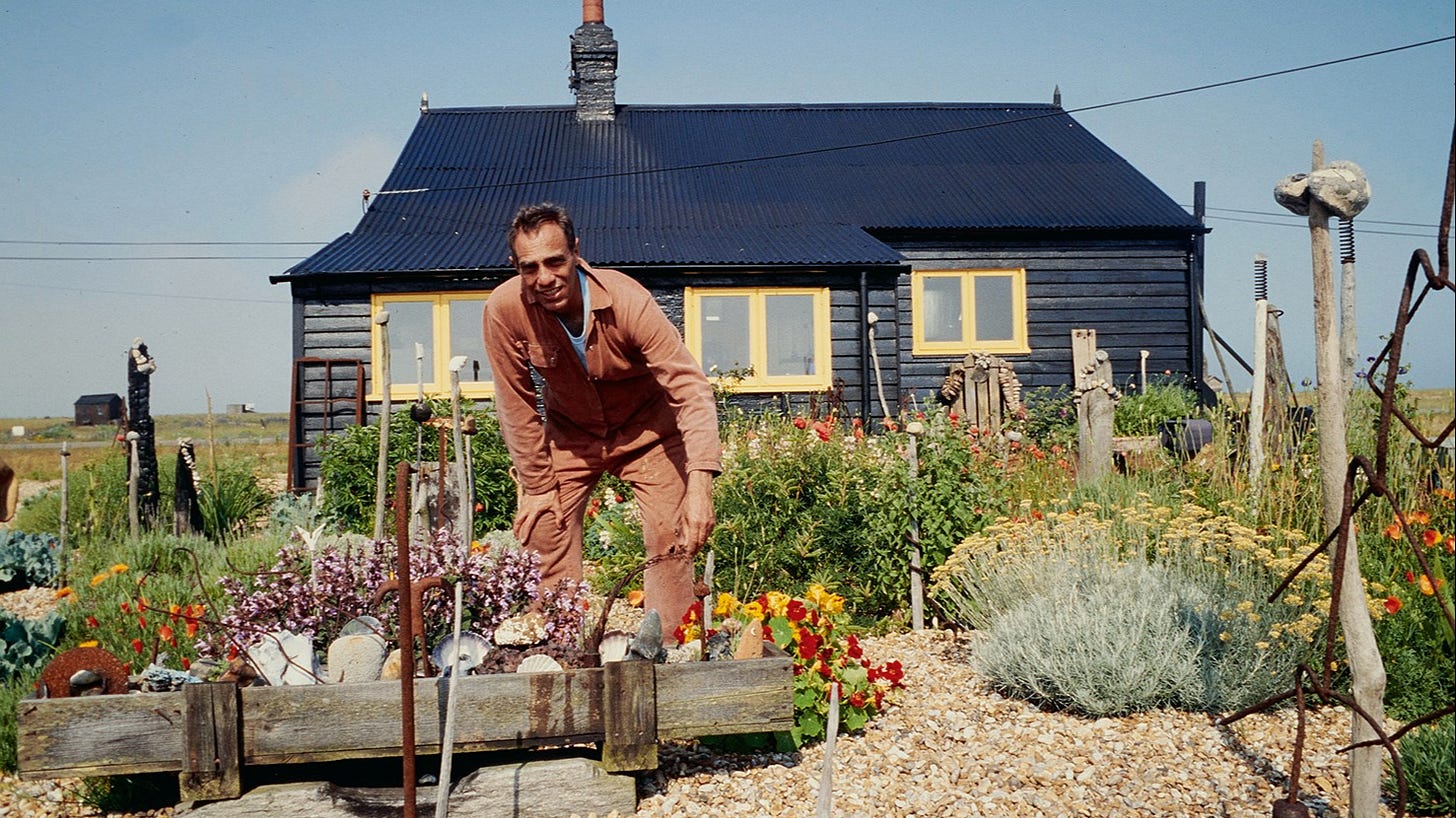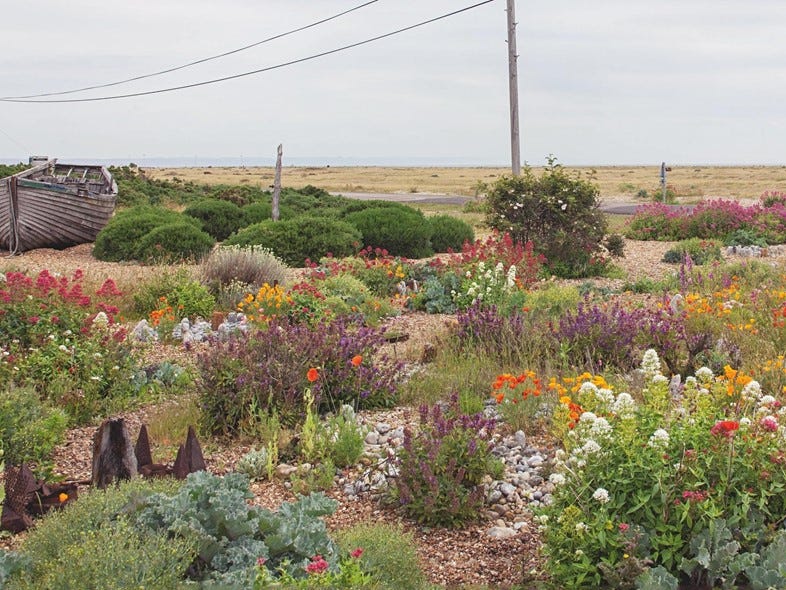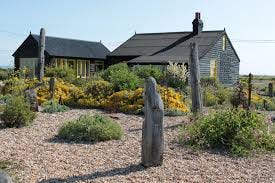Loneliness, a deeply rooted human emotion, is often associated with feelings of isolation and a lack of meaningful connections. However, for the renowned British filmmaker and artist Derek Jarman, loneliness became a transformative force that shaped his artistry. This essay explores the profound relationship between loneliness, creativity, and the unique landscape of Dungeness, a desolate coastal region in southeastern England that served as both a physical and metaphorical backdrop for Jarman's work.
Though often perceived as negative, loneliness can serve as a powerful catalyst for creative expression. In the case of Derek Jarman, the solitude he experienced due to his HIV diagnosis in the 1980s propelled him to explore his innermost thoughts and emotions through various art forms. His loneliness became a muse, driving him to create deeply introspective films, paintings, and writings.
Situated on the Kent coast, Dungeness is a remote and barren landscape characterized by its shingle beach, vast skies, and abandoned fishing boats. Its desolation mirrors the internal sense of loneliness Jarman experienced as he grappled with his illness. Dungeness became his sanctuary—a place where he could find solace amidst the vastness of the natural world.
Nature has long been regarded as a source of solace and inspiration for artists. For Jarman, Dungeness provided a unique canvas on which he could explore the interconnectedness between humans and the natural environment. Its rugged beauty and unforgiving elements became integral to his creative process, reflecting his own emotional journey and the resilience required to navigate the complexities of life.
Jarman's art often confronted themes of mortality, sexuality, and societal norms. His films, such as "Sebastiane" and "Blue," challenged traditional cinematic conventions, and his paintings boldly portrayed his personal struggles. Dungeness, with its otherworldly ambiance and stark visuals, served as a backdrop that enhanced the emotional intensity of Jarman's work. The vastness and emptiness of the landscape amplified his feelings of loneliness, enabling him to translate his inner turmoil into captivating art.
Paradoxically, Dungeness, despite its desolation, offered a sense of connection and belonging to Jarman. In this remote place, he found kindred spirits among the local community, a diverse group of individuals drawn to the area's rugged charm. Jarman's interactions with fishermen, lighthouse keepers, and gardeners who inhabited this isolated region provided him with a sense of camaraderie and a lifeline to combat his loneliness.
Derek Jarman's art and his relationship with Dungeness continue to inspire and captivate audiences today. His works offer a poignant exploration of the human condition, urging viewers to confront their own loneliness and find solace in the transformative power of creativity. Through his evocative depictions of Dungeness, Jarman immortalized both the landscape and his emotional journey, leaving an indelible mark on the art world.
Derek Jarman's relationship with loneliness and his exploration of the desolate landscape of Dungeness demonstrate the transformative power of solitude. Through his films, paintings, and writings, Jarman revealed the depths of his emotions and harnessed his loneliness as a muse. Dungeness served as a powerful backdrop, mirroring his internal struggles while providing solace and inspiration. Jarman's legacy stands as a testament to the profound connections that can be forged amidst loneliness and the power of creative expression. His ability to channel his experiences into thought-provoking and emotionally charged works continues to resonate with audiences around the world. Through his art, he invited viewers to confront their own sense of isolation and grapple with the complexities of the human condition.
The desolate landscape of Dungeness played an instrumental role in Jarman's creative journey. Its rugged beauty and vastness became a visual representation of his own internal struggles, amplifying the emotions embedded in his work. Dungeness provided him with a canvas on which to explore the interconnectedness of nature and humanity, offering a powerful reminder of the resilience required to face the challenges of life.
Beyond the physical landscape, Jarman found a sense of community and kinship within the local inhabitants of Dungeness. The fishermen, lighthouse keepers, and gardeners who shared this remote space offered him companionship and a lifeline to combat the depths of his loneliness. In their shared experiences of solitude, they found solace and strength, forming a network of support that bolstered Jarman's creative spirit.
In his final years, as his health declined, Jarman's connection to Dungeness deepened. He dedicated himself to transforming a barren plot of land into a vibrant garden, an oasis amidst the desolation. This act of creation became a testament to the resilience of the human spirit and the ability to find beauty in the most unlikely of places. His garden became a metaphorical representation of hope and a testament to the transformative power of artistic expression.
Today, Derek Jarman's influence extends far beyond his physical presence. His films, paintings, and writings continue to inspire artists and audiences alike. His legacy challenges societal norms and encourages introspection, reminding us that even in moments of loneliness, there is beauty to be found and connections to be made.
As we reflect on the relationship between loneliness, Derek Jarman, and Dungeness, we are reminded that our experiences of isolation can serve as catalysts for creativity and personal growth. Through his profound artistry and his deep connection to the desolate landscape, Jarman not only confronted his own loneliness but also invited us to examine our own inner landscapes and find solace in the transformative power of creative expression.
In the face of loneliness, Derek Jarman and Dungeness stand as testaments to the indomitable human spirit and the profound connections we can forge, reminding us that even in the most desolate of landscapes, beauty and inspiration can be discovered.
Derek Jarman (1942-1994) was an influential British artist, filmmaker, writer, and activist. Born on January 31, 1942, in Northwood, Middlesex, England, Jarman became a prominent figure in the world of contemporary art and cinema. His works often explored themes of sexuality, identity, politics, and his own personal experiences.
Jarman initially studied at the Slade School of Fine Art in London, where he developed his skills as a painter and set designer. He gained recognition for his distinctive visual style, combining various artistic mediums, including film, painting, sculpture, and writing. He worked on notable film projects such as "Sebastiane" (1976), "Caravaggio" (1986), and "Blue" (1993).
Throughout his career, Jarman was openly gay and became a prominent advocate for LGBTQ+ rights. His films often dealt with themes of homosexuality and AIDS, reflecting his personal experiences and the challenges faced by the LGBTQ+ community during the 1980s and 1990s.
Apart from filmmaking, Jarman also published several books and journals. His writings included memoirs, poetry, and political commentary. Some of his notable publications include "Modern Nature" (1991), "Chroma: A Book of Color" (1994), and "Derek Jarman's Garden" (1995).
In addition to his artistic endeavors, Jarman was actively involved in political activism, particularly in relation to gay rights and anti-nuclear movements. He used his platform to raise awareness and challenge social and political norms.
Derek Jarman's career was tragically cut short when he passed away on February 19, 1994, at the age of 52 due to complications related to AIDS. His contributions to art, film, and activism continue to inspire and influence generations of artists and activists, making him an enduring figure in contemporary British culture.











Only just, only just! You’re so welcome. Happy to share! Same, I learnt everything from you x
I love this. It really made me think about the vast spectrum of ways in which people relate to isolation; how some people crave it, flourish in it, and how it’s a horrific prospect for others. I absolutely love the photo of him, laughing in the blue shirt. Really beautiful piece.